
Four years ago, when the San Lorenzo Valley Water District voted to raise water rates 65 percent over five years, it said the money would be used for infrastructure repairs and to build a new “campus” consolidating offices in a single location in Boulder Creek. The district had already spent $2.2 million three years earlier to buy the campus site.
Ratepayers protested, especially about using some of the increase for $9 million in new offices. They collected about 2,800 protest letters – not enough to block the rate hike, but enough to convince district directors to take the rare step of changing the rate increase to 37 percent over three years, and to cancel all plans for a new campus.
Fast forward four years to 2017, when – barring the unlikelihood of nearly 4,000 protest letters – SLV water rates will be increased in November by 29 percent for a typical family, and more than 61 percent over five years.
The district may have abandoned the original “campus” plan in 2013, but it is proceeding with new plans to increase staff and to move to new offices.
The rate increase approved on July 13 and set for final adoption on Sept. 21 includes no guarantees how the money will be spent, which means it could be spent on new staff and new offices as well as pipes and storage tanks, and other infrastructure.
A 2016 staffing study recommended expanding the current staff from 26 to 36 over the next few years, which was later trimmed to 34.
A new facilities study presented to the district Board of Directors on Thursday, July 20, makes a strong case for selling the current administration building – which it said is unsafe, and violates fire codes, building codes and ADA standards – and selling an office building it owns at 12788 Highway 9 – which was part of the original 1.7-acre “campus” site.
Architect William Fisher recommended against relocating to that office building because it is a “costly, non-compliant and insufficient structure.”
The district, according to the study by architect William Fisher, should create a new facility that contains a new district office and operations center, a home for its water treatment division and laboratory and new conference space for board meetings and training. Fisher recommended against costly remodeling or reconstruction of existing district buildings.
The board Thursday was to consider Fisher’s recommendation to conduct a feasibility study to determine the cost and feasibility of various options.
All of his options included selling the office building at 12788 Highway 9, current home of a bottled water company and insurance offices, and using the adjoining empty lot next to Foster’s Freeze for a new equipment yard and operations center.
He also recommended selling both the current administration building at 13060 Highway 9 and the operations building across the street.
He said the board should building a new facility in Boulder Creek to house all offices, or consider leasing, acquiring or building a new administrative office in Ben Lomond or Felton, closer to the population center of the sprawling district. He acknowledged that “finding a suitable building(s) in Felton/Ben Lomond may be difficult or impossible.”
The vacant lot owned by the district next to Foster’s Freeze includes a wetlands area near the San Lorenzo River, for which the district prepared a “wetlands mitigation plan” in 2010 that involved allowing the old quarry at the Olympia Wellhead to flood naturally to provide a wetlands alternative.










